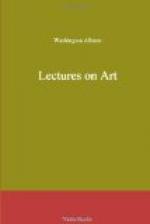both as to lines and grouping, is so distinct, both
in character and form, from the surrounding figures,
as to render them a distinct people, and their very
air reminds us of another age. We cannot but
believe we should have had a very different group,
and far superior in expression, had he given us a
conception of his own. It would at least have
been in accordance with the rest, animated with the
superstitious enthusiasm of the surrounding crowd;
and especially as sacrificing Priests would they have
been amazed and awe-stricken in the living presence
of a god, instead of personating, as in the present
group, the cold officials of the Temple, going through
a stated task at the shrine of their idol. In
the figure by Poussin, which he borrowed from Michael
Angelo, the discrepancy is still greater. The
original figure, which was in the Cartoon at Pisa,
(now known only by a print,) is that of a warrior
who has been suddenly roused from the act of bathing
by the sound of a trumpet; he has just leaped upon
the bank, and, in his haste to obey its summons, thrusts
his foot through his garment. Nothing could be
more appropriate than the violence of this action;
it is in unison with the hurry and bustle of the occasion.
And this is the figure which Poussin (without the
slightest change, if we recollect aright) has transferred
to the still and solemn scene in which John baptizes
the Saviour. No one can look at this figure without
suspecting the plagiarism. Similar instances
may be found in his other works; as in the Plague of
the Philistines, where the Alcibiades of Raffaelle
is coolly sauntering among the dead and dying, and
with as little relation to the infected multitude as
if he were still with Socrates in the School of Athens.
In the same picture may be found also one of the Apostles
from the Cartoon of the Draught of Fishes: and
we may naturally ask what business he has there.
And yet such appropriations have been made to appear
no thefts, simply because no attempt seems to have
been made at concealment! But theft, we must be
allowed to think, is still theft, whether committed
in the dark, or in the face of day. And the example
is a dangerous one, inasmuch as it comes from men
who were not constrained to resort to such shifts by
any poverty of invention.
Akin to this is another and larger kind of borrowing, which, though it cannot strictly be called copying; yet so evidently betrays a foreign origin, as to produce the same effect. We allude to the adoption of the peculiar lines, handling, and disposition of masses, &c., of any particular master.
[4] First printed in 1821, in “The Idle Man,” No. II p. 38.
[5] A feigned name.—Editor.



